1988 PONTIAC FIERO ignition
[x] Cancel search: ignitionPage 905 of 1825
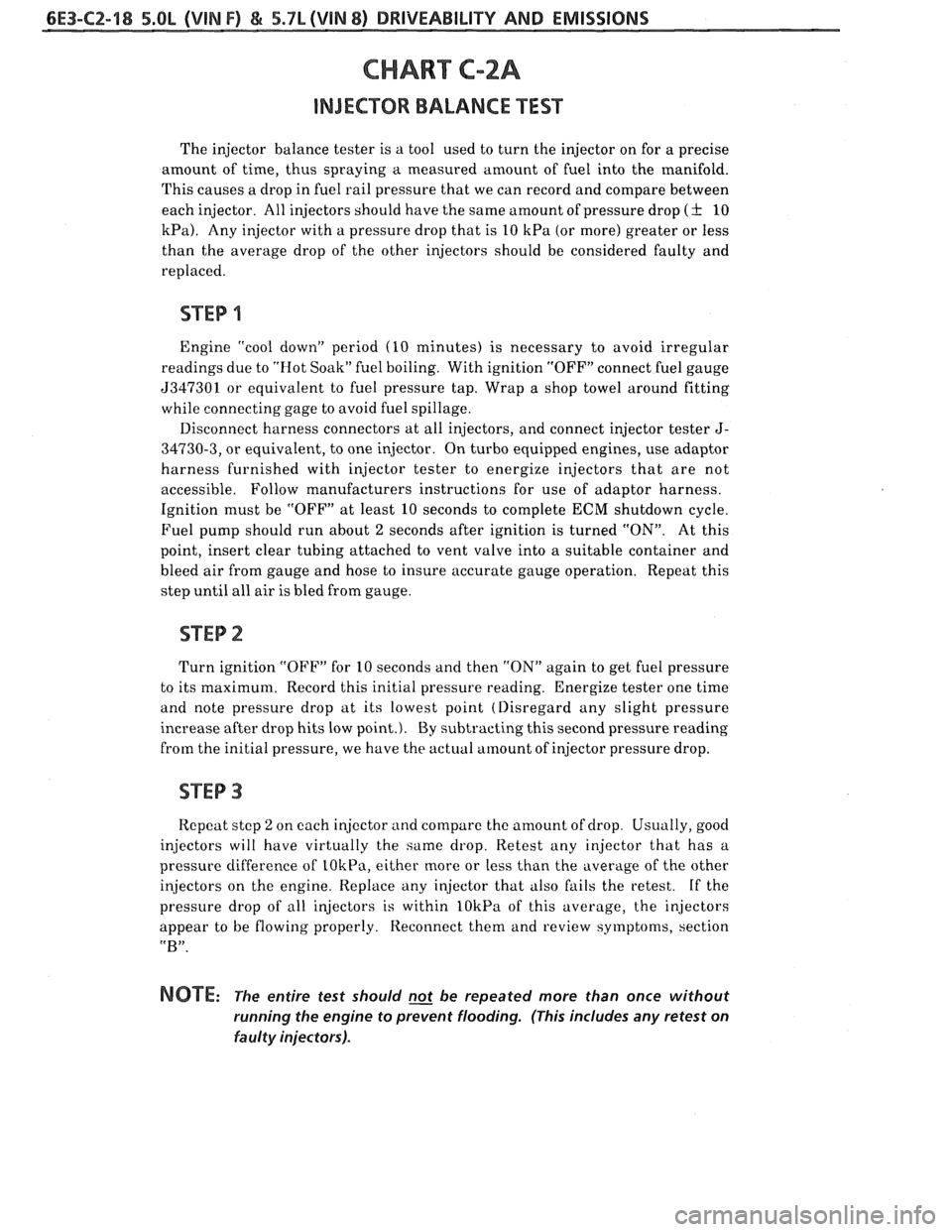
6E3-CZ-18 5.OL (VIN F) & 5.7L(VIN 8) DRIVEABILITY AND EMISSIONS
CHART C-2A
INJECWR BALANCE TEST
The injector balance tester is a tool used to turn the injector on for a precise
amount of time, thus spraying
a measured amount of fuel into the manifold.
This causes a drop in fuel rail pressure that we can record and compare between
each injector. All injectors should have the same amount of pressure drop
( f 10
kPa). Any injector with a pressure drop that is 10 kPa (or more) greater or less
than the average drop of the other injectors should be considered faulty and
replaced.
STEP 1
Engine "cool down" period (10 minutes) is necessary to avoid irregular
readings due to "Hot Soak" fuel boiling. With ignition "OFF" connect fuel gauge
5347301 or equivalent to fuel pressure tap. Wrap a shop towel around fitting
while connecting gage to avoid fuel spillage.
Disconnect harness connectors at all injectors, and connect injector tester
J-
34730-3, or equivalent, to one injector. On turbo equipped engines, use adaptor
harness furnished with injector tester to energize injectors that are not
accessible. Follow manufacturers instructions for use of adaptor harness.
Ignition must be "OFF" at least 10 seconds to complete
ECM shutdown cycle.
Fuel pump should run about
2 seconds after ignition is turned "ON". At this
point, insert clear tubing attached to vent valve into a suitable container and
bleed air from gauge and hose to insure accurate gauge operation. Repeat this
step until all air is bled from gauge.
Turn ignition
"OFF" for 10 seconds and then "ON" again to get fuel pressure
to its maximum. Record this initial pressure reading. Energize tester one time
and note pressure drop at its lowest point (Disregard any slight pressure
increase after drop hits low point.). By subtracting this second pressure reading
from the initial pressure, we have
the actual amount of injector pressure drop.
STEP 3
Rcpcat stcp 2 on each injector and compare the amount of drop. Usually, good
injectors will have virtually the same drop. Retest any injector that has a
pressure difference of
LOkPa, either more or less than the average of the other
injectors on the engine. Replace any injector that also fails the retest.
If the
pressure drop of all injectors is within
lOkPa of this average, the injectors
appear to be flowing properly. Reconnect them and review symptoms, section
"B".
NOTE: The entire test should not be repeated more than once without
running the engine to prevent flooding. (This includes any retest on
faulty injectors).
Page 906 of 1825
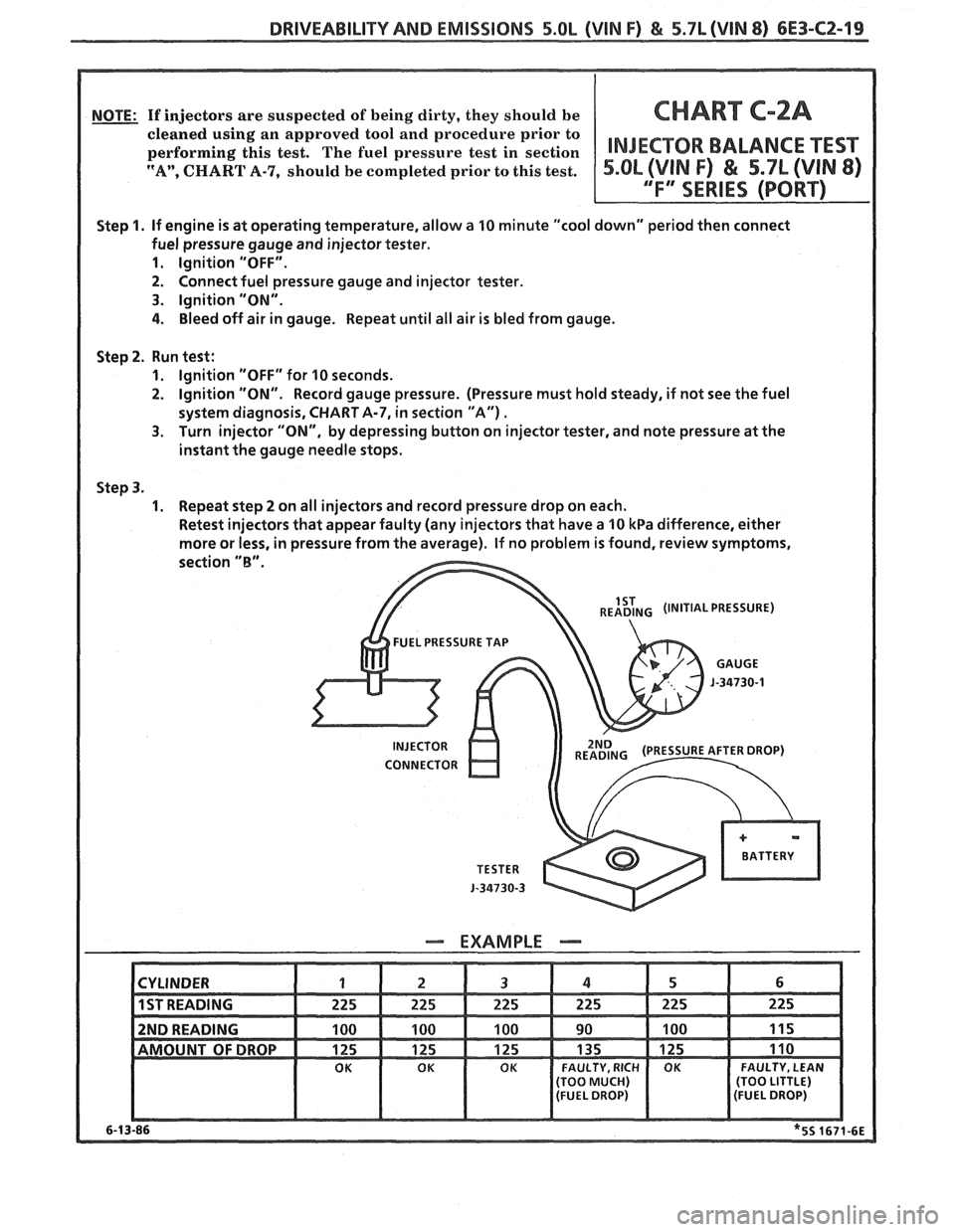
DRIVEABILITY AND EMISSIONS 5.OL (VIN F) & 5.7L (VIN 8) 6E3-CZ-19
NOTE: If injectors are suspected of being dirty, they should be CHART Cm2A
INJEGWOR BALANCE TEST
Step 1. If engine is at operating temperature, allow a 10 minute "cool down" period then connect
fuel pressure gauge and injector tester.
1. Ignition "OFF".
2. Connect fuel pressure gauge and injector tester.
3. Ignition "ON".
4. Bleed off air in gauge. Repeat until all air is bled from gauge.
1. Ignition "OFF" for 10 seconds.
2. Ignition "ON". Record gauge pressure. (Pressure must hold steady, if not see the fuel
system diagnosis, CHART A-7, in section
"A") .
3. Turn injector "ON", by depressing button on injector tester, and note pressure at the
instant the gauge needle stops.
1. Repeat step 2 on all injectors and record pressure drop on each.
Retest injectors that appear faulty (any injectors that have a 10
kPa difference, either
Page 907 of 1825
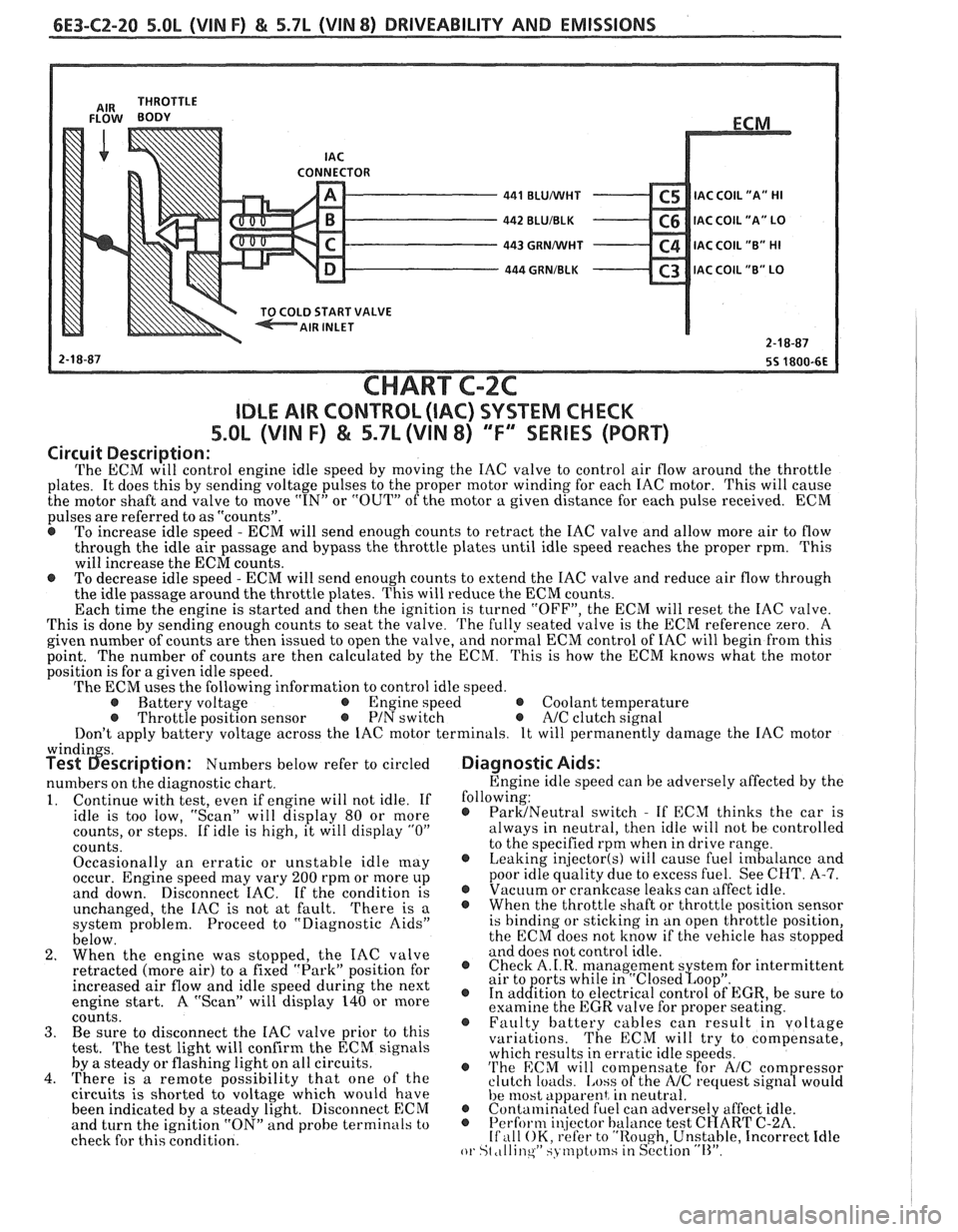
6E3-C2-20 5.0L (VIN F) & 5.7L (WIN 8) DRIVEABILITY AND EMISSIONS
CONNECTOR - 441 BLUMlHT C5 IAC C0lL1'A" HI - 442 BLUIBLK C6 IAC COIL "A" LO - 443 GRNMlHT C4 IAC COIL "B" HI - 444 GRNIBLK C3 lAC COIL "B" LO v
START VALVE
CHART C-2C
IDLE AIR CONTROL (IAC) SYSTEM CHECK
S.OL (VIN F) & 5.7L (VIN 8) "F'" SERIES (PORT)
Circuit Description:
The ECM will control engine idle speed by moving the IAC valve to control air flow around the throttle
plates. It does this by sending voltage pulses to the proper motor winding for each IAC motor. This will cause
the motor shaft and valve to move
"IN" or "OUT" of the motor a given distance for each pulse received. ECM
pulses are referred to as "counts".
@ To increase idle speed - ECM will send enough counts to retract the IAC valve and allow more air to flow
through the idle air passage and bypass the throttle plates until idle speed reaches the proper rpm. This
will increase the ECM counts.
e To decrease idle speed - ECM will send enough counts to extend the IAC valve and reduce air flow through
the idle passage around the throttle plates. This will reduce the ECM counts.
Each time the engine is started and then the ignition is turned "OFF", the ECM will reset the IAC valve.
This is done by sending enough counts to seat the valve.
The fully seated valve is the ECM reference zero. A
given number of counts are then issued to open the valve, and normal ECM control of IAC will begin from this
point. The
number of counts are then calculated by the ECM. This is how the ECM knows what the motor
position is for a given idle speed.
The ECM uses the following information to control idle speed.
@ Battery voltage @ Engine speed @ Coolant temperature @ Throttle position sensor @ PIN switch e A/C clutch signal
Don't apply battery voltage across the IAC motor terminals. It will permanently damage the IAC motor
windin s. Test 6escription: Numbers below refer to circled
numbers on the diagnostic chart.
1. Continue with test, even if engine will not idle. If
idle is too low, "Scan" will display 80 or more
counts, or steps. If idle is high, it will display
"0"
counts.
Occasionally an erratic or unstable idle
[nay occur. Engine speed may vary 200 rpm or more up
and down. Disconnect IAC. If the condition is
unchanged, the IAC is not at fault.
There is a
system problem. Proceed to "Diagnostic Aids"
below.
2. When the engine was stopped, the IAC valve
retracted (more air) to
a fixed "Park" position for
increased air flow and idle speed during the next
engine start. A "Scan" will display 140 or more
coiints. 3. Be sure to disconnect the IAC valve prior to this
test.
The test light will confirm the ECM signals
by a steady or flashing light on all circuits.
4. There is a remote possibility that one of the
circuits is shorted to voltage which would have
been indicated by a steady light. Disconnect ECM
and turn the ignition "ON" and probe terminals to
check for this condition.
Diagnostic Aids:
Engine idle speed can be adversely affected by the
following:
@ ParMNeutral switch - If ECM thinks the car is
always in neutral, then idle will not be controlled
to the specified rpm when in drive range.
@ Leaking injector(s) will cause fuel imbalance and
poor idle quality due to excess fuel. See CHT.
A-7. @ Vacuum or crankcase leaks can affect idle. @ Whenthethrottleshaftorthrottlepositionsensor
is binding or sticking in an open throttle position,
the ECM does not know if the vehicle has stopped
and does not control idle.
@ Check A.I.R. management s stem for intermittent
air to orts while in "~losed~oo~". @ In ad&tion to electrical control of EGR, be sure to
examine the EGR valve for proper seating.
@ Faulty battery cables can result in voltage
variations. The ECM will try to compensate,
which results in erratic idle speeds.
@ 'I'he ECM will com ensate for A/C com ressor
clutch loacls. [.ass ofthe NC request sign8 would
he 11lost apparent, in neutral. @ Contalninatecl fuel can adverse1 affect idle. @ Perform i~!jector balance test C~ART C-2A. If ,111 OK, refer to "Rough, Unstable, Incorrect Idle or St ,tllinqW SJ tnptcfinsiin S~'ction "11''.
Page 916 of 1825
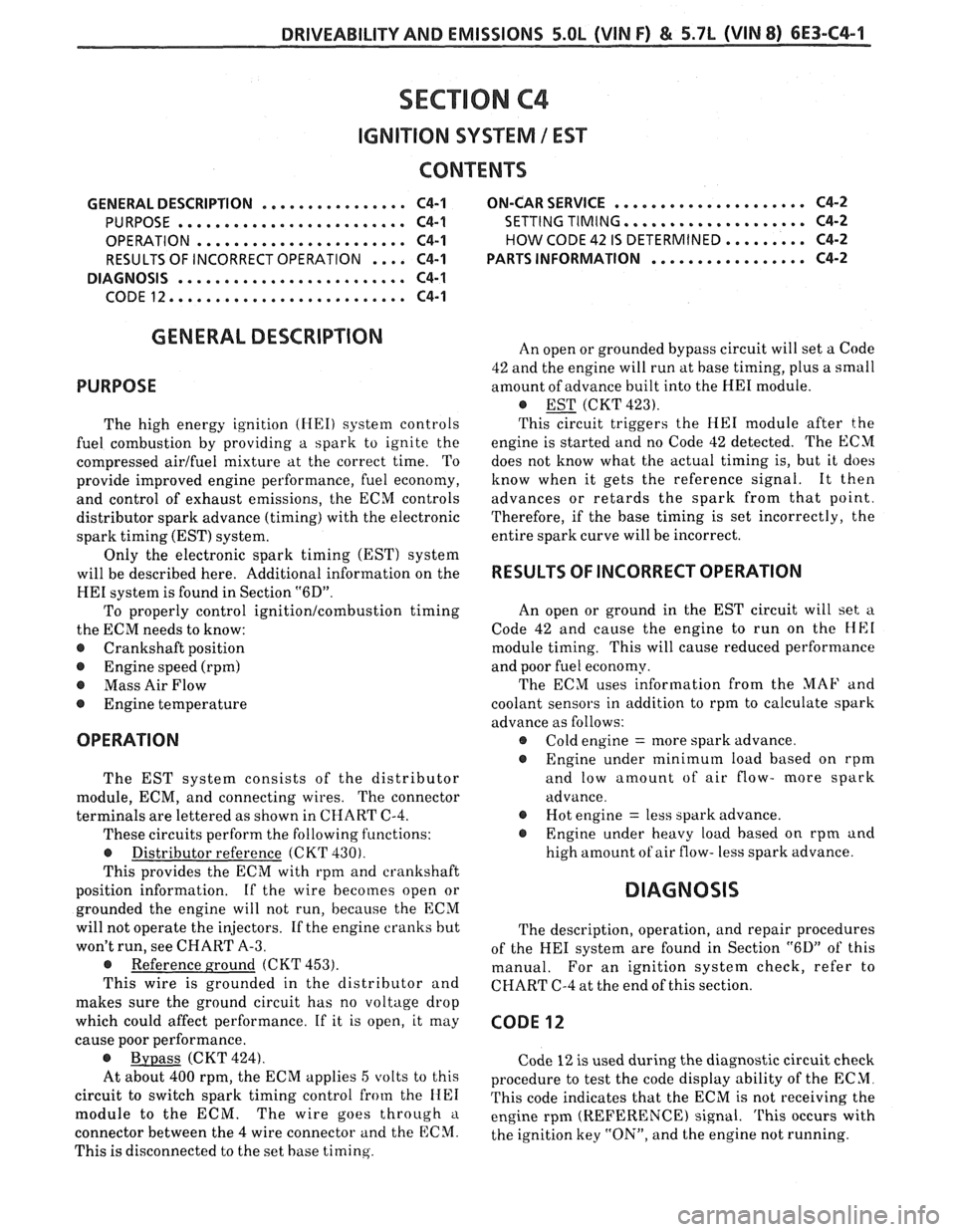
DRIVEABILITY AND EMISSIONS 5.OL (VIN F) & 5.7L (VIN 8) 6E3-C4-1
SECTION C4
IGNIION SYSTEM 1 EST
..................... GENERAL DESCRIPTION ................ C4-1 ON-CAR SERVICE C4-2
.................. PURPOSE ......................... C4-1 SETTING TIMING.. C4-2
OPERATION ....................... C4-1 HOW CODE 42 IS DETERMINED.. ....... C4-2
................. RESULTS OF INCORRECT OPERATION .... C4-1 PARTS INFORMATION C4-2
DIAGNOSIS ......................... C4-1
CODE12.......................... C4-1
GENERAL DESCRIPTION
PURPOSE
The high energy ignition (HEI) system controls
fuel combustion by providing a spark to ignite the
compressed
airlfuel mixture at the correct time. To
provide improved engine performance, fuel economy,
and control of exhaust emissions, the
ECM controls
distributor spark advance (timing) with the electronic
spark timing (EST) system.
Only the electronic spark timing (EST) system
will be described here. Additional information on the
FIE1 system is found in Section "6D".
To properly control ignitionlcombustion timing
the ECM needs to know:
e Crankshaft position
e Engine speed (rpm)
@ Mass Air Flow
@ Engine temperature
OPERATION
The EST system consists of the distributor
module, ECM, and connecting wires. The connector
terminals are lettered as shown in CHART C-4.
These circuits perform the following functions:
@ Distributor reference (CKT 430).
This provides the ECM with rpm and crankshaft
position information.
If the wire becomes open or
grounded the engine will not run, because the ECM
will not operate the injectors.
If the engine cranks hut
won't run, see CHART
A-3.
e Reference ground (CKT 453).
This wire is grounded in the distributor and
makes sure the ground circuit has no voltage drop
which could affect performance. If it is open, it may
cause poor performance.
@ Bvpass (CKT 424).
At about 400 rpm, the ECM applies
5 volts to this
circuit to switch spark timing control from the
I-IEI
module to the ECM. The wire goes through a
connector between the 4 wire connector and the ECM.
This is disconnected to the set hase timing. An
open or grounded bypass circuit will set a Code
42 and the engine will run at base timing, plus a small
amount of advance built into the
HE1 module.
@ EST (CKT 423). - This circuit triggers the HE1 module after the
engine is started and no Code 42 detected. The ECM
does not know what the actual timing is, but it does
know when it gets the reference signal. It then
advances or retards the spark from that point.
Therefore, if the base timing is set incorrectly, the
entire spark curve will be incorrect.
RESULTS OF INCORRECT OPERATION
An open or ground in the EST circuit will set u
Code 42 and cause the engine to run on the HE1
module timing. This will cause reduced performance
and poor fuel economy.
The ECM uses information from the
MAE' and
coolant sensors in addition to rpm to calculate spark
advance as follows:
e Cold engine = more spark advance.
r Engine under minimum load based on rpm
and low amount of air flow- more spark
advance. Hot engine
= less spark advance.
@ Engine under heavy load based on rpm and
high amount
of air flow- less spark advance.
DIAGNOSIS
The description, operation, and repair procedures
of the
HE1 system are found in Section "6D" of this
manual. For an ignition system check, refer to
CHART C-4 at the end of this section.
CODE 12
Code 12 is used during the diagnostic circuit check
procedure to test the code display ability of the
ECM
This code indicates that the ECM is not receiving the
engine rpm (REFERENCE) signal.
'Phis occurs with
the ignition key
"ON", and the engine not running.
Page 919 of 1825
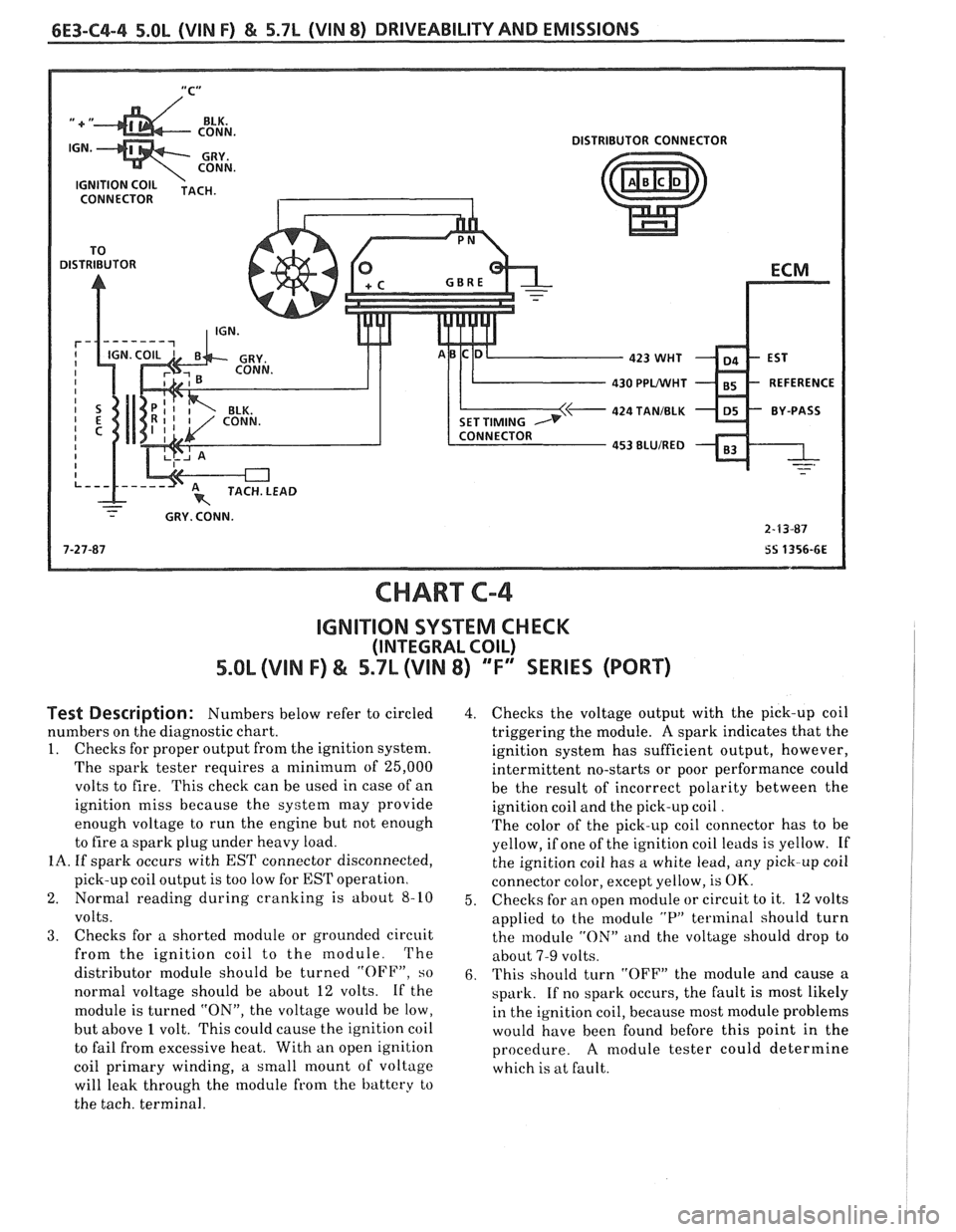
6E3-C4-4 5.OL (VIN F) & 5.7L (VIN 8) DRIVEABILITY AND EMISSIONS
"C" /
DISTRIBUTOR CONNECTOR
CONNECTOR
430 PPLNVHT
424 TANIBLK
- - - GRY. CONN.
2-F3-87
7-27-87
SS 1356-6E
CHART C-4
IGNITION SYSTEM CHECK
(INTEGRAL COIL)
5.0b (VIN F) & 5.7L (VIN 8) "F" SERIES (PORT)
Test Description: Numbers below refer to circled
numbers on the diagnostic chart.
1. Checks for proper output from the ignition system.
The spark tester requires a minimum of 25,000
volts to fire. This check can be used in case of an
ignition miss because the system may provide
enough voltage to run the engine but not enough
to fire a spark plug under heavy load.
IA. If spark occurs with EST connector disconnected,
pick-up coil output is too low for
EST operation.
2. Normal reading during cranking is about
8-10
volts.
3. Checks for a shorted module or grounded circuit
from the ignition coil to the module. The
distributor module should be turned
"OFF", so
normal voltage should be about 12 volts. If the
module is turned
"ON", the voltage would be low,
but above
1 volt. This could cause the ignition coil
to fail from excessive heat. With an open ignition
coil primary winding,
a small mount of voltage
will leak through the module from the battery to
the tach. terminal.
4. Checks the voltage output with the pick-up coil
triggering the module.
A spark indicates that the
ignition system has sufficient output, however,
intermittent no-starts or poor performance could
be the result of incorrect polarity between the
ignition coil and the pick-up coil
.
The color of the pick-up coil connector has to be
yellow, if one of the ignition coil leads is yellow. If
the ignition coil has a white lead, any pick-up coil
connector color, except yellow, is
OK.
5. Checks
for an open module or circuit to it. 12 volts
applied to the module
"P" terminal should turn
the module
"ON" and the voltage should drop to
about
7-9 volts.
6. This should turn "OFF" the module and cause a
spark. If no spark occurs, the fault is most likely
in the ignition coil, because most module problems
would have been found before this point in the
procedure.
A module tester could determine
which is at fault.
Page 936 of 1825
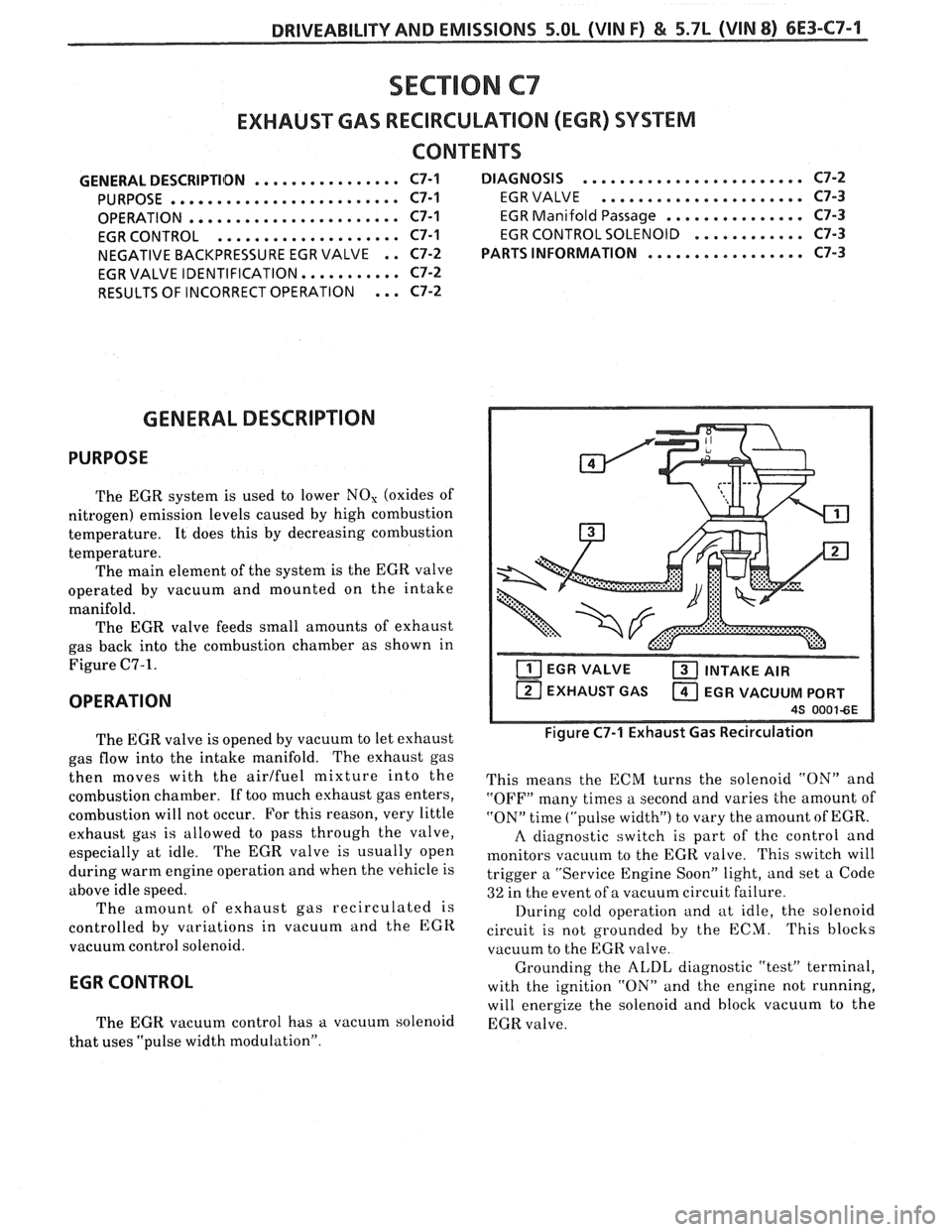
DRIVEABILITY AND EMISSIONS 5.0L (VIN F) €4 5.7L (VIN 8) 6E3-C7-1
SECTION C7
EXHAUST GAS REClRCULATlON (EGR) SYSTEM
CONTENTS
................ GENERAL DESCRIPTIlDN C7-1 DIAGNOSIS ........................ C7-2
PURPOSE
......................... C7-1 EGR VALVE ...................... C7-3
....................... OPERATION C7-1 EGR Manifold Passage ............... C7-3
.................... EGR CONTROL C7-1
EGR CONTROL SOLENOID ............ C7-3
NEGATIVE BACKPRESSURE EGR VALVE
. . C7-2 PARTS INFORMATION ................. C7-3
......... EGR VALVE IDENTIFICATION.. C7-2
... RESULTS OF INCORRECT OPERATION C7-2
GENERAL DESCRIPTION
PURPOSE
The EGR system is used to lower NO, (oxides of
nitrogen) emission levels caused by high combustion
temperature. It does this by decreasing combustion
temperature. The main element of the system is the EGR valve
operated by vacuum and mounted on the intake
manifold.
The EGR valve feeds small amounts of exhaust
gas back into the combustion chamber as shown in
Figure
C7-1.
OPERATION
The EGR valve is opened by vacuum to let exhaust
gas flow into the intake manifold. The exhaust gas
then moves with the
airlfuel mixture into the
combustion chamber.
If too much exhaust gas enters,
combustion will not occur. For this reason, very little
exhaust gas is allowed to pass through the valve,
especially at idle. The EGR valve is usually open
during warm engine operation and when the vehicle is
above idle speed. The amount of exhaust gas recirculated is
controlled by variations in vacuum and the
EGR
vacuum control solenoid.
EGR CONTROL
The EGR vacuum control has a vacuum solenoid
that uses "pulse width modulation".
EGR VALVE INTAKE AIR
EXHAUST GAS EGR VACUUM PORT
Figure C7-1 Exhaust Gas Recirculation
This means the ECM turns the solenoid "ON" and
"OFF" many times a second and varies the amount of
"ON" time ("pulse width") to vary the amount of EGR.
A diagnostic switch is part of the control and
monitors vacuum to the EGR valve. This switch will
trigger a "Service Engine Soon" light, and set a Code
32 in the event of a vacuum circuit failure.
During cold operation and at idle, the solenoid
circuit is not grounded by the ECM. This blocks
vacuum to the EGR valve.
Grounding the
ALDL diagnostic "test" terminal,
with the ignition "ON" and the engine not running,
will energize the solenoid and block vacuum to the
EGR valve.
Page 939 of 1825
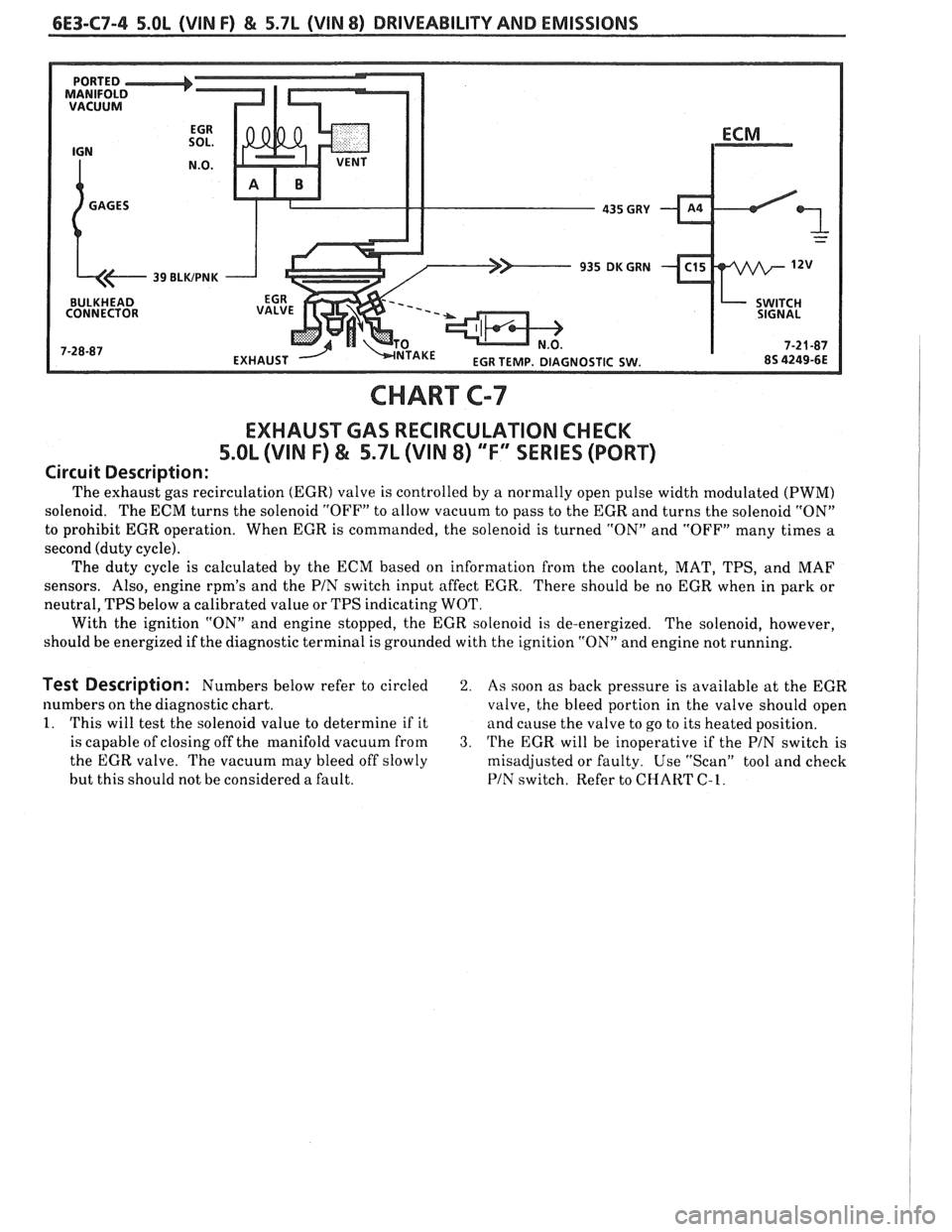
6E3-C7-4 5.OL (VIN F) €4 5.7L (VIN 8) DRIVEABILITY AND EMISSIONS
CHART C-7
EXHAUST GAS RECIRCULATION CHECK
5.OL (VIN F) & 5.7L (VIN 8) "F" SERIES (PORT)
Circuit Description:
The exhaust gas recirculation (EGR) valve is controlled by a normally open pulse width modulated (PWM)
solenoid. The ECM turns the solenoid "OFF" to allow vacuum to pass to the EGR and turns the solenoid "ON"
to prohibit EGR operation. When EGR is commanded, the solenoid is turned "ON" and "OFF" many times a
second (duty cycle).
The duty cycle is calculated by the ECM based on information from the coolant, MAT, TPS, and MAF
sensors. Also, engine
rpm's and the PIN switch input affect EGR.
There should be no EGR when in park or
neutral, TPS below
a calibrated value or TPS indicating WOT.
With the ignition "ON" and engine stopped, the EGR solenoid is de-energized. The solenoid, however,
should be energized if the diagnostic terminal is grounded with the ignition "ON" and engine not running.
Test Description: Numbers below refer to circled 2. As soon as back pressure is available at the EGR
numbers on the diagnostic chart.
valve, the bleed portion in the valve should open
1. This will test the solenoid value to determine if it
and cause the valve to go to its heated position.
is capable of closing off the manifold vacuum from
3. 'I'he EGR will be inoperative if the PIN switch is
the EGR valve. The vacuum may bleed off slowly
misadjusted or faulty. Use "Scan" tool and check
but this should not be considered a fault.
PIN switch. Refer to CHART C-1.
Page 948 of 1825
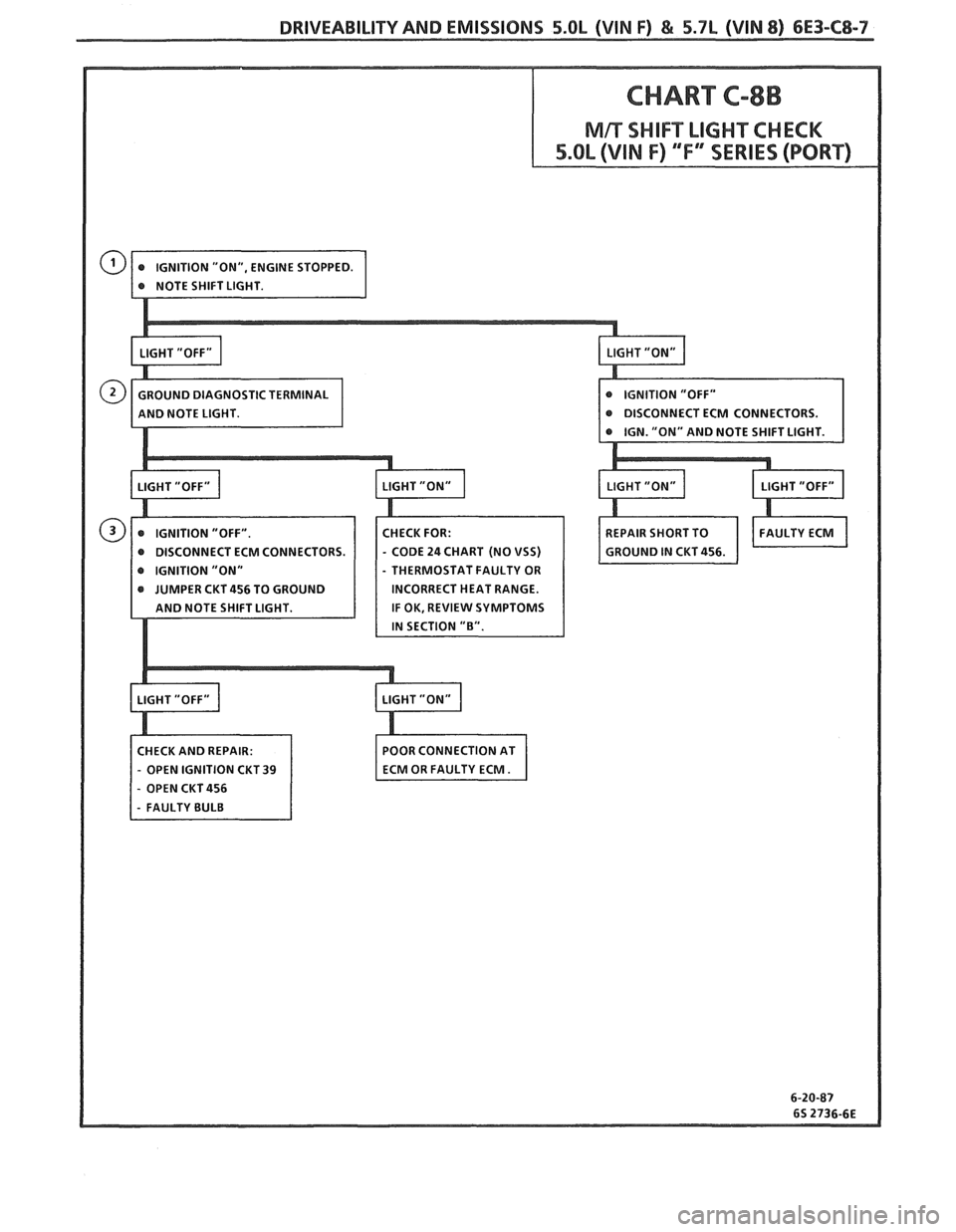
DRIVEABILITVAND EMISSIONS 5.OL (VIN F) & 5.7L (VIN 8) 6E3-C8-7
@ DISCONNECT ECM CONNECTORS.
@ DISCONNECT ECM CONNECTORS - CODE 24 CHART (NO VSS)
- THERMOSTAT FAULTY OR
INCORRECT HEAT RANGE.
IF OK, REVIEW SYMPTOMS
CHECK AND REPAIR: POOR
CONNECTION AT
- OPEN IGNITION CKT 39
- OPEN CKT 456